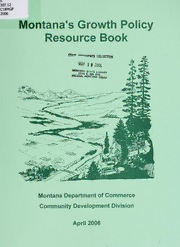
Montana's growth policy resource book PDF
Preview Montana's growth policy resource book
b 307.12 C18MGP 2006 Montana's Growth Policy Resource Book mrr •^«*»MMrNTS COLLECTION MAV i d 2006 MONTANA SiMlEL.aKARV Montana Department of Commerce Community Development Division April 2006 MontanaStaleLibrary 116 2*"0"0'7 lili!lllfll'l!fi'lllllil'!ll|lifT'lirliilrii"^'|^!li'i"'i 3 0864 1003 8935 5 MONTANA'S GROWTH POLICY RESOURCE BOOK Montana DepartmentofCommerce Community Development Division 301 S. Park P.O. Box200523 Helena, Montana 59620-0523 Phone: (406)841-2770 Fax: (406)841-2771 E-mail: [email protected] Website: http://comdev.mt.gov/ April, 2006 : FOREWORD This publication, Montana's Growth Policy Resource Book, is intended to assist people involved with county and municipal planning in Montana. This publication describes and interprets the requirementsof76-1-601, MCA, Montana'sGrowthPolicylawenactedbythe 1999legislature. The best approach forpreparing a community growth policy is a topicthat can sparkstrong debate among professional planners and citizen planning board members. Ultimately, each communitywill havetodecideontheapproachthatworksbestforthem. The staffofthe Montana Department ofCommerce, Community Development Division, Community Technical Assistance Program (CTAP) originally prepared this book in 2003. Participants in the project included RichardWeddle, DivisionAttorney; GavinAnderson, CTAP Program Manager; Kelly Shields, CTAP Planner IV, and Mary Vandenbosch, Resource Policy Analyst with the Legislative ServicesDivision. Laterin 2003, the Montana Legislature, facedwith a $300 million deficit, made a numberofcuts in state programs to balance the budget, including eliminating the Community Technical Assistance Program. TheGrowthPolicyResourceBookwasrevisedandupdatedin2006byateamconsistingof: • DaveCole,AdministratorofCommunityDevelopmentDivision; • Gus Byrom, Manager of the Community Development Block Grant Program (Housing and PublicFacilities); • JimEdgcomb,ManageroftheTreasureStateEndowmentProgram,and • DorisFischer, PlanningDirectorforMadisonCounty. Weviewthis publication as"aworkin progress"and invite yourcomments orsuggestionsforhowit canbeimprovedandmademoreusefulforMontanalocalgovernments. Thepreparation ofthispublication was funded, inpart, with technicalassistance fundsprovidedby the CommunityDevelopmentBlockGrant(CDBG) Program, U.S. DepartmentofHousingandUrban Development(HUD). The Montana CDBG program provides matching grants to local governments forthe preparation of GrowthPolicies. Formoreinformationcontact CDBGProgram-HousingandPublicFacilities MDOC/CommunityDevelopmentDivision 301 SouthParkAvenue-P.O. Box200523 Helena, MT 59620-0523 Phone:(406)841-2791 TDD:(406)841-2702 FAX: (406)841-2771 Website: http://comdev.mt.gov/CDD cdbg.asp Upon request, the information provided in this publication will be made available in an alternativeaccessibleformat. CONTENTS Foreword Preface 1 Chapter1-IntroductiontoGrowthPolicies 4 Montana'sNewPlanning Law 4 GrowthPolicyOverview 6 PreparingaGrowthPolicy 7 Chapter2-DevelopmentofGoalsandObjectives 9 GoalsandObjectives 9 GoalsandObjectivesStatements 11 PublicParticipation 12 Chapter3-RequiredElementsoftheGrowthPolicy 14 Maps 14 LandUse 14 Transportation 16 Population 18 HousingNeeds 18 EconomicConditions 20 LocalFacilitiesandServices 21 PublicFacilities 24 NaturalResources 26 OtherElementsoftheGrowthPolicy 27 ProjectedTrends 29 Summary 30 Chapter4-OtherGrowthPolicyRequirements 31 ImplementationTools 31 StrategyforPublicInfrastructure 31 GrowthPolicyImplementationStrategy 32 StatementofInterjurisdictionalCooperation 32 SubdivisionReviewStatement 32 PublicHearingStatement 33 AdoptionoftheGrowthPolicy 33 Chapter5-ImplementationoftheGrowthPolicy 34 General 34 RelationshipofGrowthPolicytoLandUseRegulations 34 SubdivisionRegulations 35 Zoning Regulations 35 RelationshipoftheGrowthPolicytoZoningRegulations 37 BoardofAdjustment 37 InterimZoningRegulations 38 ProtestofCountyZoning 38 ExtraterritorialProvisions 38 DevelopmentPermitRegulations 38 DevelopmentStandards 38 PointSystems 39 FloodplainRegulations 40 LakeShoreRegulations 41 ConservationEasements 41 Capital ImprovementsPlanandCapitalBudget 41 SpecialPlans 42 CommunityImprovementProjects 43 OtherPotential ImplementationTools 44 Chapter4-EvaluationoftheGrowthPolicy 45 APPENDICES AppendixA: UrbanandRuralGrowthinMontana 46 AppendixB:GrowthPolicyStatute(76-1-601,MCA) 60 AppendixC: PossibleDefinitionsForTermsUsedIn76-3-608(3)(a),MCA 65 AppendixD:InternetSitesThatMayBeUseful 66 AppendixE:GrowthPolicyChecklist 69 " PREFACE "Theonlyconstantischange, continuingchange,inevitablechange;thatisthe dominantfactorinsocietytoday. Nosensibledecisioncanbemadeanylonger withouttakingintoaccount,notonlytheworldasitis,buttheworldasitwillbe. -IsaacAsimov Therewereapproximately240,000peoplelivinginMontanain 1900. By2000,thestatehad902,195 residents, anincreaseof662,195people. By2005, Montana'spopulationwas935,670. Some areas ofMontana saw significant increases in population during the 1990's. While Montana's population grewbyabout 10percentbetween 1990and 1999, several countiessawincreasesof20 percentormoreduringthistimeperiodincluding: Increase1990to 1999 Increase2000to2005 D BroadwaterCounty Accordingto Swanson, someofthepeople movingtoMontana areolderwith adequatesavingsand retirement income. More and more retirees are skipping the warmer, but increasingly crowded, SunbeltstatesandchoosingthenorthernRockiesstateslikeMontana. TheCensus Bureausaysthe populationofpersons65andolderwillincreasefasterintheWestthananyotherareaofthecountry. Increasing numbers are middle-aged people with at least part oftheir income based on retirement income, investmentearnings, orsavings. Manyofthemdon'thavetoworkfull-timetolivein Montana orhave outside sources ofincometo supplement a Montanajob. Others have sold homes in "hot" realestatemarketsandpurchased replacementhomesin Montanaatsubstantially lowercost, giving them instantcash andsavingstodrawupon. With accesstothe Internet, manyofthese immigrants possess skills in the "knowledge" industries such as consulting, investments, research, and writing thatallowthemtoliveanywhereand"telecommute". Onestudysaidthatretireeswhomigratetendtobehealthier,wealthier, and bettereducated. Alotof these peoplewantto be located in smalltowns. Whilequality oflife is part ofthe attraction, lower costhousing isalsoamajordraw. Someofthese"immigrantretirees"areactuallynative Montanans who spenttheirworking careers elsewhere andwho nowhavethetimeand resourcesto be ableto returntoMontana. Oneorganization,"TheComeHomeMontana Project"hasorganizedastatewide efforttoencourageformerMontananstoreturnand, hopefully, tobhngtheirbusinessesandjobswith them. If people aren't from Montana, but would enjoy Montana's lifestyle, they are encouraged to come,too.ThegroupisworkingtogetallMontanacommunitiestoparticipate. (Website; http://www.comehomemontana.org/>) Demographerstell usthatthistrend is likelytosurgeeven more, beginning in2008, whenthefirstof the "baby boomers" become eligible for early Social Security retirement. Some 77 million "baby boomers"wereborn between 1946and 1964. Sincethepeakofthe"boomers" arestill intheirmid- fifties,thistrendislikelytocontinue,nationwide,fortwentysomeyears. It also appears that this growth is principally impacting county governments, ratherthan cities and towns. A 2001 study by the Department ofCommerce indicated thatforthe fifteen fastestgrowing counties, the majority of growth has occurred in unincorporated areas. The study is included in AppendixA, UrbanandRuralGrowthinMontana. Some communities* may view these demographic trends as a threat, others as a potential opportunity. In a round about way, this brings us to why community planning is important. Some communities may be concerned about how rapid growth will change their community. Other communities maybeconcernedabouthowthe lackofgrowthoractualdecline in populationwill hurt theircommunity. Montanans are notcomplacent; theycarevery much about howtheircommunities look and the quality of life in them. Community planning is a critical tool to helpthem manage this change. Whethergrowingordeclining, manyMontanacommunitiesareworkingtocreateavisionfor their future and developing growth policies under Montana's new planning law to accomplish that vision. Forcommunities that are declining in population or growing slowly, the term "growth policy" may not seem appropriate; it is their option if they choose to refer to the document using the traditionalterm"comprehensiveplan". The EnvironmentalQualityCouncil report, PlanningforGrowthinMontana, identifiedseveralbenefits ofcommunityplanning: D Reducesincreasesintaxesandfeestlirouglimoreefficientprovisionofsen/ices. D Fosterswiseandttiougtitfulinvestmentsinmajorpublicfacilities, suchasroads, waterandsewer systems, solidwaste, andfireprotection. n Makes communities saferandhealthierby encouraging well-designed streets, protecting water quality, anddeterringdevelopmentinunsuitableareassuchasfloodplains, wetlands, faultzones, andunstableslopes. D Helpstomakeacommunitymoreattractivetoinvestmentbybusinessesandindustries. D Protectsspecialcommunityvalues, suchashistoric, cultural, scenicandnaturalfeatures, orrural, 2
